Environmental Impact of International Trade Liberalisation
VerifiedAdded on 2021/06/17
|15
|4209
|21
Essay
AI Summary
This essay delves into the intricate relationship between international trade liberalization and environmental change. It examines the positive aspects of trade, such as economic development and resource utilization, while also highlighting the negative impacts, including increased pollution, greenhouse gas emissions, and global warming. The essay traces the evolution of trade policies, from protectionism to liberalization, and analyzes how this shift has influenced social and environmental dimensions. It discusses the role of multinational corporations, the emergence of environmental concerns in trade negotiations, and the relevance of green objectives. The essay further explores the scale, composition, and technique effects of trade liberalization on the environment and concludes by emphasizing the need for regulations and restrictions to mitigate the adverse consequences of international trade on the planet. The discussion also highlights pollution problems and remedies, including the role of politics in environmental conservation.
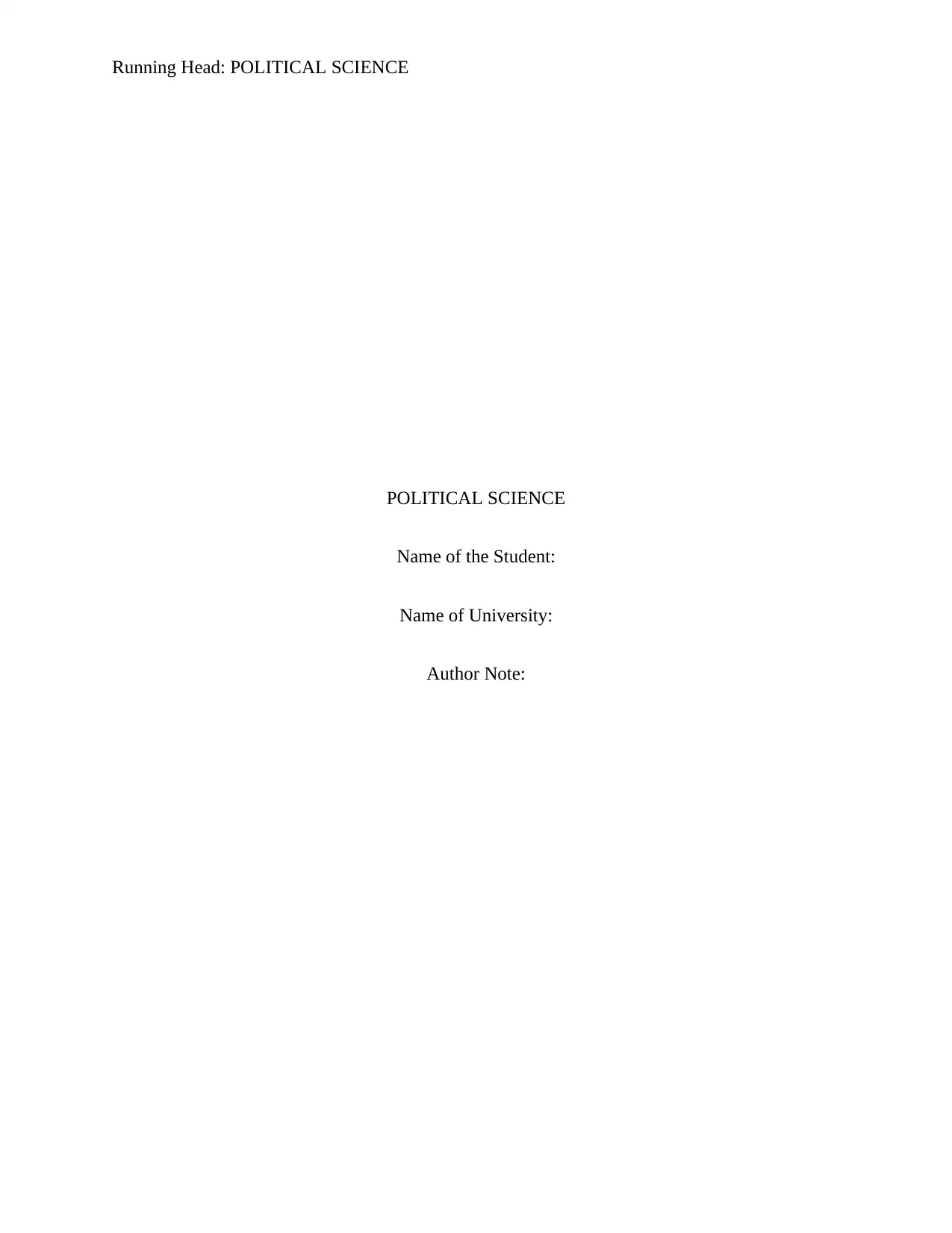
Running Head: POLITICAL SCIENCE
POLITICAL SCIENCE
Name of the Student:
Name of University:
Author Note:
POLITICAL SCIENCE
Name of the Student:
Name of University:
Author Note:
Paraphrase This Document
Need a fresh take? Get an instant paraphrase of this document with our AI Paraphraser
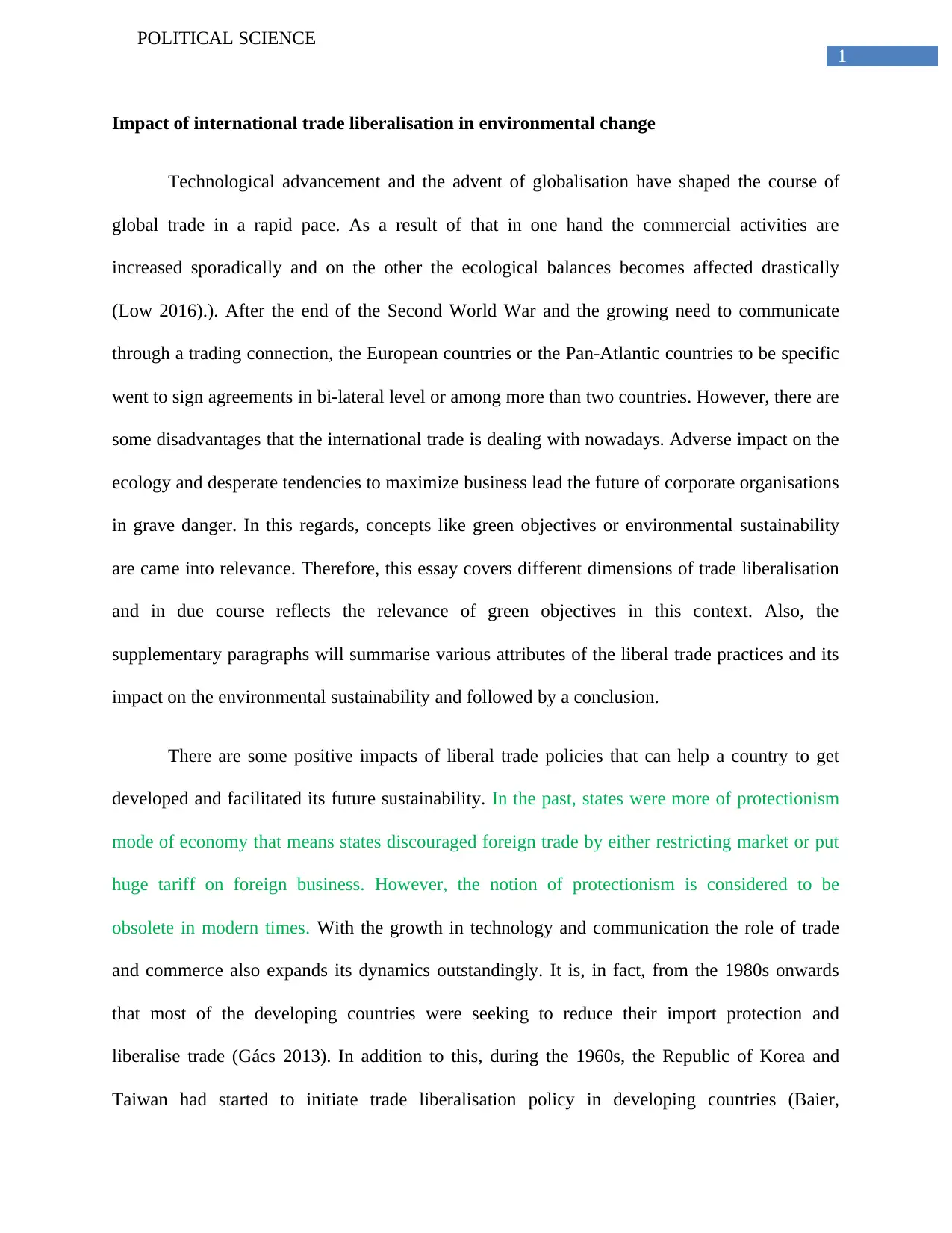
1
POLITICAL SCIENCE
Impact of international trade liberalisation in environmental change
Technological advancement and the advent of globalisation have shaped the course of
global trade in a rapid pace. As a result of that in one hand the commercial activities are
increased sporadically and on the other the ecological balances becomes affected drastically
(Low 2016).). After the end of the Second World War and the growing need to communicate
through a trading connection, the European countries or the Pan-Atlantic countries to be specific
went to sign agreements in bi-lateral level or among more than two countries. However, there are
some disadvantages that the international trade is dealing with nowadays. Adverse impact on the
ecology and desperate tendencies to maximize business lead the future of corporate organisations
in grave danger. In this regards, concepts like green objectives or environmental sustainability
are came into relevance. Therefore, this essay covers different dimensions of trade liberalisation
and in due course reflects the relevance of green objectives in this context. Also, the
supplementary paragraphs will summarise various attributes of the liberal trade practices and its
impact on the environmental sustainability and followed by a conclusion.
There are some positive impacts of liberal trade policies that can help a country to get
developed and facilitated its future sustainability. In the past, states were more of protectionism
mode of economy that means states discouraged foreign trade by either restricting market or put
huge tariff on foreign business. However, the notion of protectionism is considered to be
obsolete in modern times. With the growth in technology and communication the role of trade
and commerce also expands its dynamics outstandingly. It is, in fact, from the 1980s onwards
that most of the developing countries were seeking to reduce their import protection and
liberalise trade (Gács 2013). In addition to this, during the 1960s, the Republic of Korea and
Taiwan had started to initiate trade liberalisation policy in developing countries (Baier,
POLITICAL SCIENCE
Impact of international trade liberalisation in environmental change
Technological advancement and the advent of globalisation have shaped the course of
global trade in a rapid pace. As a result of that in one hand the commercial activities are
increased sporadically and on the other the ecological balances becomes affected drastically
(Low 2016).). After the end of the Second World War and the growing need to communicate
through a trading connection, the European countries or the Pan-Atlantic countries to be specific
went to sign agreements in bi-lateral level or among more than two countries. However, there are
some disadvantages that the international trade is dealing with nowadays. Adverse impact on the
ecology and desperate tendencies to maximize business lead the future of corporate organisations
in grave danger. In this regards, concepts like green objectives or environmental sustainability
are came into relevance. Therefore, this essay covers different dimensions of trade liberalisation
and in due course reflects the relevance of green objectives in this context. Also, the
supplementary paragraphs will summarise various attributes of the liberal trade practices and its
impact on the environmental sustainability and followed by a conclusion.
There are some positive impacts of liberal trade policies that can help a country to get
developed and facilitated its future sustainability. In the past, states were more of protectionism
mode of economy that means states discouraged foreign trade by either restricting market or put
huge tariff on foreign business. However, the notion of protectionism is considered to be
obsolete in modern times. With the growth in technology and communication the role of trade
and commerce also expands its dynamics outstandingly. It is, in fact, from the 1980s onwards
that most of the developing countries were seeking to reduce their import protection and
liberalise trade (Gács 2013). In addition to this, during the 1960s, the Republic of Korea and
Taiwan had started to initiate trade liberalisation policy in developing countries (Baier,
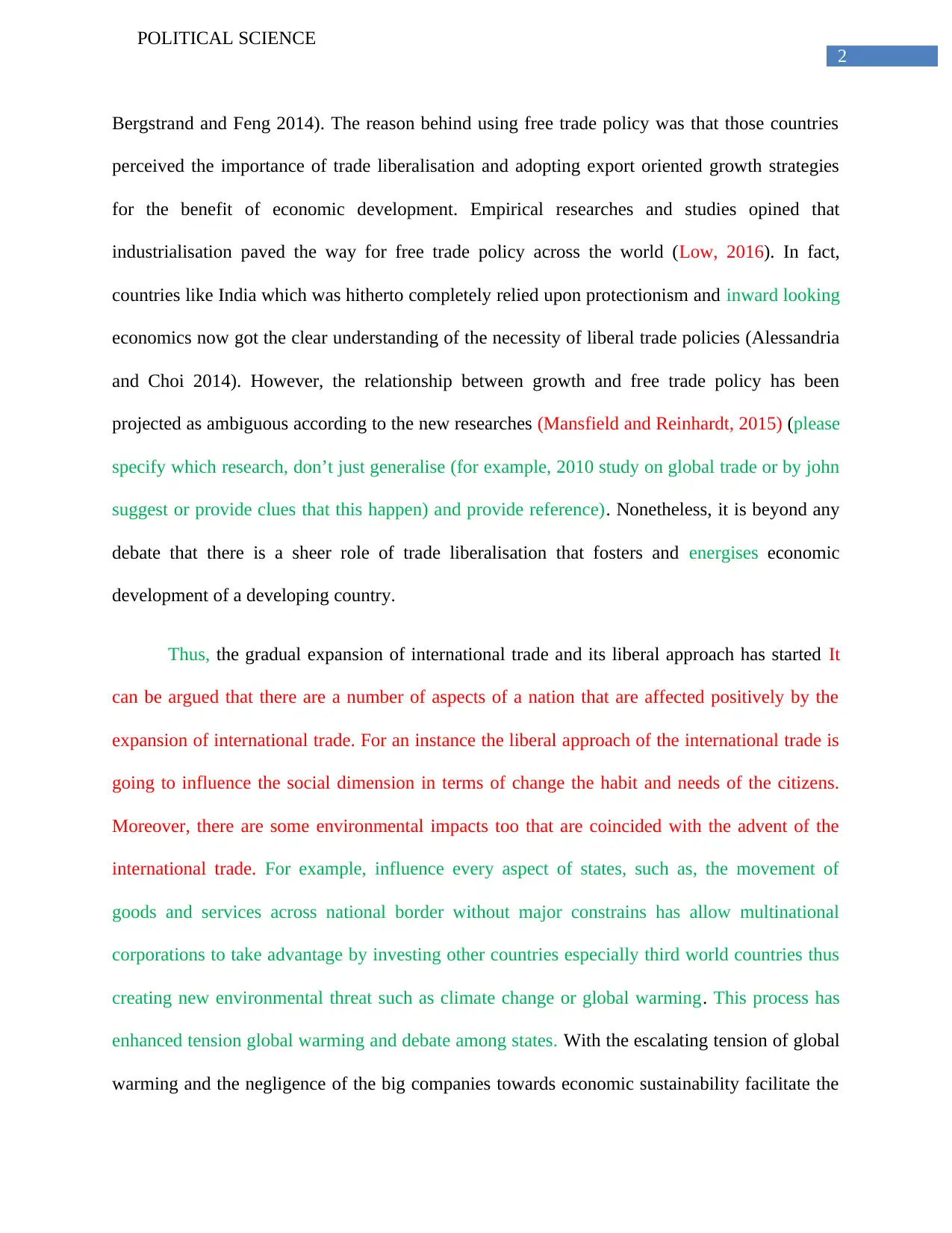
2
POLITICAL SCIENCE
Bergstrand and Feng 2014). The reason behind using free trade policy was that those countries
perceived the importance of trade liberalisation and adopting export oriented growth strategies
for the benefit of economic development. Empirical researches and studies opined that
industrialisation paved the way for free trade policy across the world (Low, 2016). In fact,
countries like India which was hitherto completely relied upon protectionism and inward looking
economics now got the clear understanding of the necessity of liberal trade policies (Alessandria
and Choi 2014). However, the relationship between growth and free trade policy has been
projected as ambiguous according to the new researches (Mansfield and Reinhardt, 2015) (please
specify which research, don’t just generalise (for example, 2010 study on global trade or by john
suggest or provide clues that this happen) and provide reference). Nonetheless, it is beyond any
debate that there is a sheer role of trade liberalisation that fosters and energises economic
development of a developing country.
Thus, the gradual expansion of international trade and its liberal approach has started It
can be argued that there are a number of aspects of a nation that are affected positively by the
expansion of international trade. For an instance the liberal approach of the international trade is
going to influence the social dimension in terms of change the habit and needs of the citizens.
Moreover, there are some environmental impacts too that are coincided with the advent of the
international trade. For example, influence every aspect of states, such as, the movement of
goods and services across national border without major constrains has allow multinational
corporations to take advantage by investing other countries especially third world countries thus
creating new environmental threat such as climate change or global warming. This process has
enhanced tension global warming and debate among states. With the escalating tension of global
warming and the negligence of the big companies towards economic sustainability facilitate the
POLITICAL SCIENCE
Bergstrand and Feng 2014). The reason behind using free trade policy was that those countries
perceived the importance of trade liberalisation and adopting export oriented growth strategies
for the benefit of economic development. Empirical researches and studies opined that
industrialisation paved the way for free trade policy across the world (Low, 2016). In fact,
countries like India which was hitherto completely relied upon protectionism and inward looking
economics now got the clear understanding of the necessity of liberal trade policies (Alessandria
and Choi 2014). However, the relationship between growth and free trade policy has been
projected as ambiguous according to the new researches (Mansfield and Reinhardt, 2015) (please
specify which research, don’t just generalise (for example, 2010 study on global trade or by john
suggest or provide clues that this happen) and provide reference). Nonetheless, it is beyond any
debate that there is a sheer role of trade liberalisation that fosters and energises economic
development of a developing country.
Thus, the gradual expansion of international trade and its liberal approach has started It
can be argued that there are a number of aspects of a nation that are affected positively by the
expansion of international trade. For an instance the liberal approach of the international trade is
going to influence the social dimension in terms of change the habit and needs of the citizens.
Moreover, there are some environmental impacts too that are coincided with the advent of the
international trade. For example, influence every aspect of states, such as, the movement of
goods and services across national border without major constrains has allow multinational
corporations to take advantage by investing other countries especially third world countries thus
creating new environmental threat such as climate change or global warming. This process has
enhanced tension global warming and debate among states. With the escalating tension of global
warming and the negligence of the big companies towards economic sustainability facilitate the
⊘ This is a preview!⊘
Do you want full access?
Subscribe today to unlock all pages.

Trusted by 1+ million students worldwide
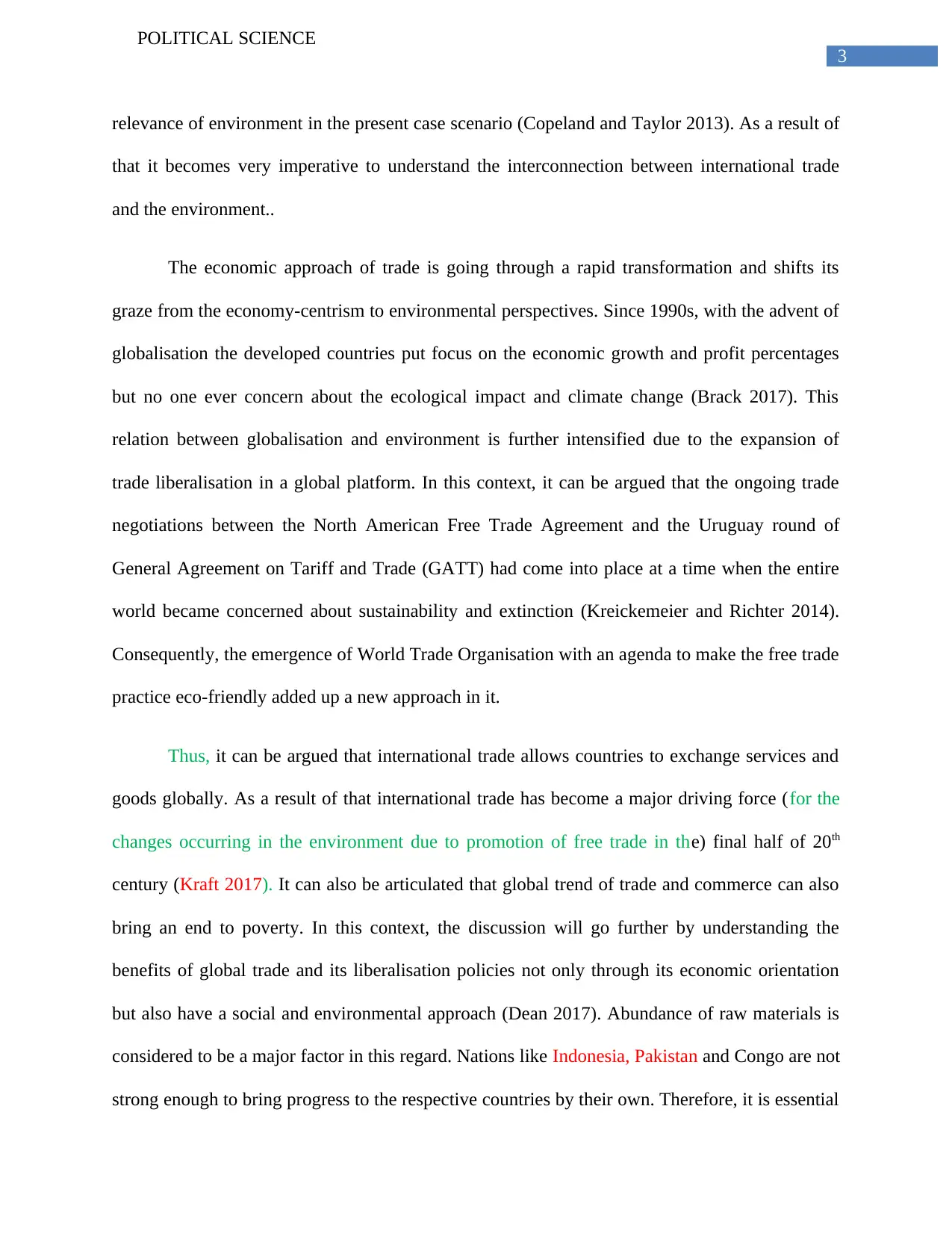
3
POLITICAL SCIENCE
relevance of environment in the present case scenario (Copeland and Taylor 2013). As a result of
that it becomes very imperative to understand the interconnection between international trade
and the environment..
The economic approach of trade is going through a rapid transformation and shifts its
graze from the economy-centrism to environmental perspectives. Since 1990s, with the advent of
globalisation the developed countries put focus on the economic growth and profit percentages
but no one ever concern about the ecological impact and climate change (Brack 2017). This
relation between globalisation and environment is further intensified due to the expansion of
trade liberalisation in a global platform. In this context, it can be argued that the ongoing trade
negotiations between the North American Free Trade Agreement and the Uruguay round of
General Agreement on Tariff and Trade (GATT) had come into place at a time when the entire
world became concerned about sustainability and extinction (Kreickemeier and Richter 2014).
Consequently, the emergence of World Trade Organisation with an agenda to make the free trade
practice eco-friendly added up a new approach in it.
Thus, it can be argued that international trade allows countries to exchange services and
goods globally. As a result of that international trade has become a major driving force (for the
changes occurring in the environment due to promotion of free trade in the) final half of 20th
century (Kraft 2017). It can also be articulated that global trend of trade and commerce can also
bring an end to poverty. In this context, the discussion will go further by understanding the
benefits of global trade and its liberalisation policies not only through its economic orientation
but also have a social and environmental approach (Dean 2017). Abundance of raw materials is
considered to be a major factor in this regard. Nations like Indonesia, Pakistan and Congo are not
strong enough to bring progress to the respective countries by their own. Therefore, it is essential
POLITICAL SCIENCE
relevance of environment in the present case scenario (Copeland and Taylor 2013). As a result of
that it becomes very imperative to understand the interconnection between international trade
and the environment..
The economic approach of trade is going through a rapid transformation and shifts its
graze from the economy-centrism to environmental perspectives. Since 1990s, with the advent of
globalisation the developed countries put focus on the economic growth and profit percentages
but no one ever concern about the ecological impact and climate change (Brack 2017). This
relation between globalisation and environment is further intensified due to the expansion of
trade liberalisation in a global platform. In this context, it can be argued that the ongoing trade
negotiations between the North American Free Trade Agreement and the Uruguay round of
General Agreement on Tariff and Trade (GATT) had come into place at a time when the entire
world became concerned about sustainability and extinction (Kreickemeier and Richter 2014).
Consequently, the emergence of World Trade Organisation with an agenda to make the free trade
practice eco-friendly added up a new approach in it.
Thus, it can be argued that international trade allows countries to exchange services and
goods globally. As a result of that international trade has become a major driving force (for the
changes occurring in the environment due to promotion of free trade in the) final half of 20th
century (Kraft 2017). It can also be articulated that global trend of trade and commerce can also
bring an end to poverty. In this context, the discussion will go further by understanding the
benefits of global trade and its liberalisation policies not only through its economic orientation
but also have a social and environmental approach (Dean 2017). Abundance of raw materials is
considered to be a major factor in this regard. Nations like Indonesia, Pakistan and Congo are not
strong enough to bring progress to the respective countries by their own. Therefore, it is essential
Paraphrase This Document
Need a fresh take? Get an instant paraphrase of this document with our AI Paraphraser
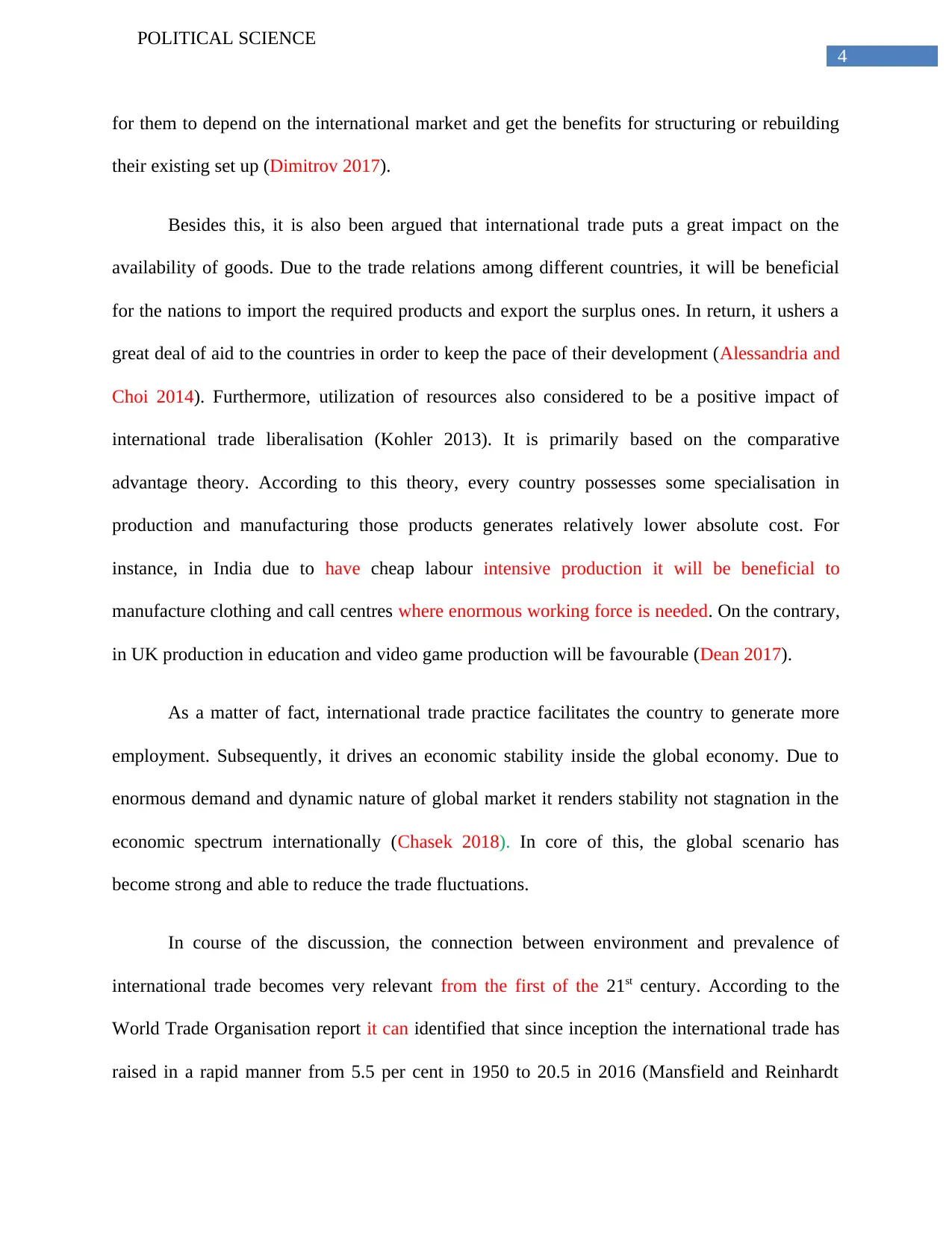
4
POLITICAL SCIENCE
for them to depend on the international market and get the benefits for structuring or rebuilding
their existing set up (Dimitrov 2017).
Besides this, it is also been argued that international trade puts a great impact on the
availability of goods. Due to the trade relations among different countries, it will be beneficial
for the nations to import the required products and export the surplus ones. In return, it ushers a
great deal of aid to the countries in order to keep the pace of their development (Alessandria and
Choi 2014). Furthermore, utilization of resources also considered to be a positive impact of
international trade liberalisation (Kohler 2013). It is primarily based on the comparative
advantage theory. According to this theory, every country possesses some specialisation in
production and manufacturing those products generates relatively lower absolute cost. For
instance, in India due to have cheap labour intensive production it will be beneficial to
manufacture clothing and call centres where enormous working force is needed. On the contrary,
in UK production in education and video game production will be favourable (Dean 2017).
As a matter of fact, international trade practice facilitates the country to generate more
employment. Subsequently, it drives an economic stability inside the global economy. Due to
enormous demand and dynamic nature of global market it renders stability not stagnation in the
economic spectrum internationally (Chasek 2018). In core of this, the global scenario has
become strong and able to reduce the trade fluctuations.
In course of the discussion, the connection between environment and prevalence of
international trade becomes very relevant from the first of the 21st century. According to the
World Trade Organisation report it can identified that since inception the international trade has
raised in a rapid manner from 5.5 per cent in 1950 to 20.5 in 2016 (Mansfield and Reinhardt
POLITICAL SCIENCE
for them to depend on the international market and get the benefits for structuring or rebuilding
their existing set up (Dimitrov 2017).
Besides this, it is also been argued that international trade puts a great impact on the
availability of goods. Due to the trade relations among different countries, it will be beneficial
for the nations to import the required products and export the surplus ones. In return, it ushers a
great deal of aid to the countries in order to keep the pace of their development (Alessandria and
Choi 2014). Furthermore, utilization of resources also considered to be a positive impact of
international trade liberalisation (Kohler 2013). It is primarily based on the comparative
advantage theory. According to this theory, every country possesses some specialisation in
production and manufacturing those products generates relatively lower absolute cost. For
instance, in India due to have cheap labour intensive production it will be beneficial to
manufacture clothing and call centres where enormous working force is needed. On the contrary,
in UK production in education and video game production will be favourable (Dean 2017).
As a matter of fact, international trade practice facilitates the country to generate more
employment. Subsequently, it drives an economic stability inside the global economy. Due to
enormous demand and dynamic nature of global market it renders stability not stagnation in the
economic spectrum internationally (Chasek 2018). In core of this, the global scenario has
become strong and able to reduce the trade fluctuations.
In course of the discussion, the connection between environment and prevalence of
international trade becomes very relevant from the first of the 21st century. According to the
World Trade Organisation report it can identified that since inception the international trade has
raised in a rapid manner from 5.5 per cent in 1950 to 20.5 in 2016 (Mansfield and Reinhardt
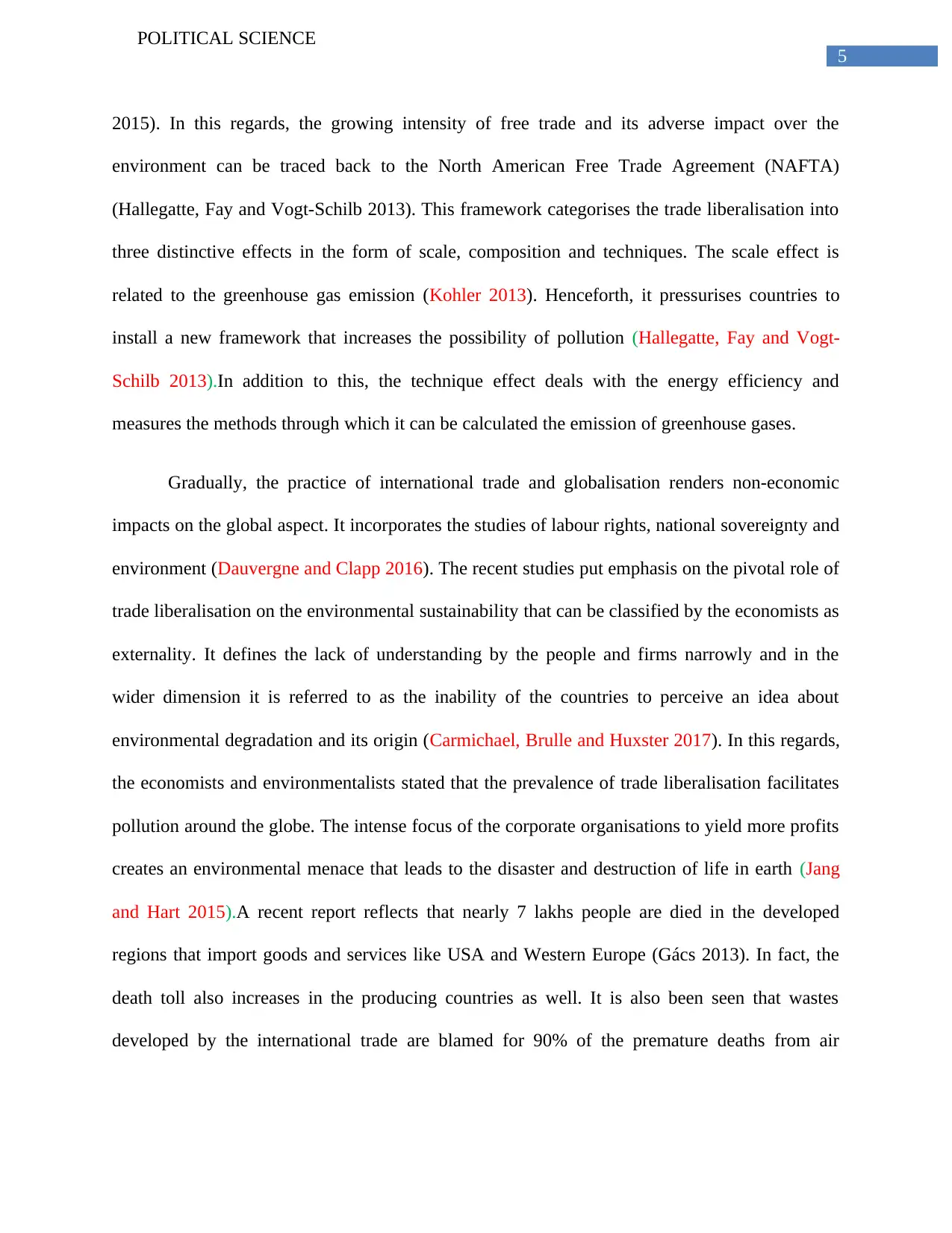
5
POLITICAL SCIENCE
2015). In this regards, the growing intensity of free trade and its adverse impact over the
environment can be traced back to the North American Free Trade Agreement (NAFTA)
(Hallegatte, Fay and Vogt-Schilb 2013). This framework categorises the trade liberalisation into
three distinctive effects in the form of scale, composition and techniques. The scale effect is
related to the greenhouse gas emission (Kohler 2013). Henceforth, it pressurises countries to
install a new framework that increases the possibility of pollution (Hallegatte, Fay and Vogt-
Schilb 2013).In addition to this, the technique effect deals with the energy efficiency and
measures the methods through which it can be calculated the emission of greenhouse gases.
Gradually, the practice of international trade and globalisation renders non-economic
impacts on the global aspect. It incorporates the studies of labour rights, national sovereignty and
environment (Dauvergne and Clapp 2016). The recent studies put emphasis on the pivotal role of
trade liberalisation on the environmental sustainability that can be classified by the economists as
externality. It defines the lack of understanding by the people and firms narrowly and in the
wider dimension it is referred to as the inability of the countries to perceive an idea about
environmental degradation and its origin (Carmichael, Brulle and Huxster 2017). In this regards,
the economists and environmentalists stated that the prevalence of trade liberalisation facilitates
pollution around the globe. The intense focus of the corporate organisations to yield more profits
creates an environmental menace that leads to the disaster and destruction of life in earth (Jang
and Hart 2015).A recent report reflects that nearly 7 lakhs people are died in the developed
regions that import goods and services like USA and Western Europe (Gács 2013). In fact, the
death toll also increases in the producing countries as well. It is also been seen that wastes
developed by the international trade are blamed for 90% of the premature deaths from air
POLITICAL SCIENCE
2015). In this regards, the growing intensity of free trade and its adverse impact over the
environment can be traced back to the North American Free Trade Agreement (NAFTA)
(Hallegatte, Fay and Vogt-Schilb 2013). This framework categorises the trade liberalisation into
three distinctive effects in the form of scale, composition and techniques. The scale effect is
related to the greenhouse gas emission (Kohler 2013). Henceforth, it pressurises countries to
install a new framework that increases the possibility of pollution (Hallegatte, Fay and Vogt-
Schilb 2013).In addition to this, the technique effect deals with the energy efficiency and
measures the methods through which it can be calculated the emission of greenhouse gases.
Gradually, the practice of international trade and globalisation renders non-economic
impacts on the global aspect. It incorporates the studies of labour rights, national sovereignty and
environment (Dauvergne and Clapp 2016). The recent studies put emphasis on the pivotal role of
trade liberalisation on the environmental sustainability that can be classified by the economists as
externality. It defines the lack of understanding by the people and firms narrowly and in the
wider dimension it is referred to as the inability of the countries to perceive an idea about
environmental degradation and its origin (Carmichael, Brulle and Huxster 2017). In this regards,
the economists and environmentalists stated that the prevalence of trade liberalisation facilitates
pollution around the globe. The intense focus of the corporate organisations to yield more profits
creates an environmental menace that leads to the disaster and destruction of life in earth (Jang
and Hart 2015).A recent report reflects that nearly 7 lakhs people are died in the developed
regions that import goods and services like USA and Western Europe (Gács 2013). In fact, the
death toll also increases in the producing countries as well. It is also been seen that wastes
developed by the international trade are blamed for 90% of the premature deaths from air
⊘ This is a preview!⊘
Do you want full access?
Subscribe today to unlock all pages.

Trusted by 1+ million students worldwide
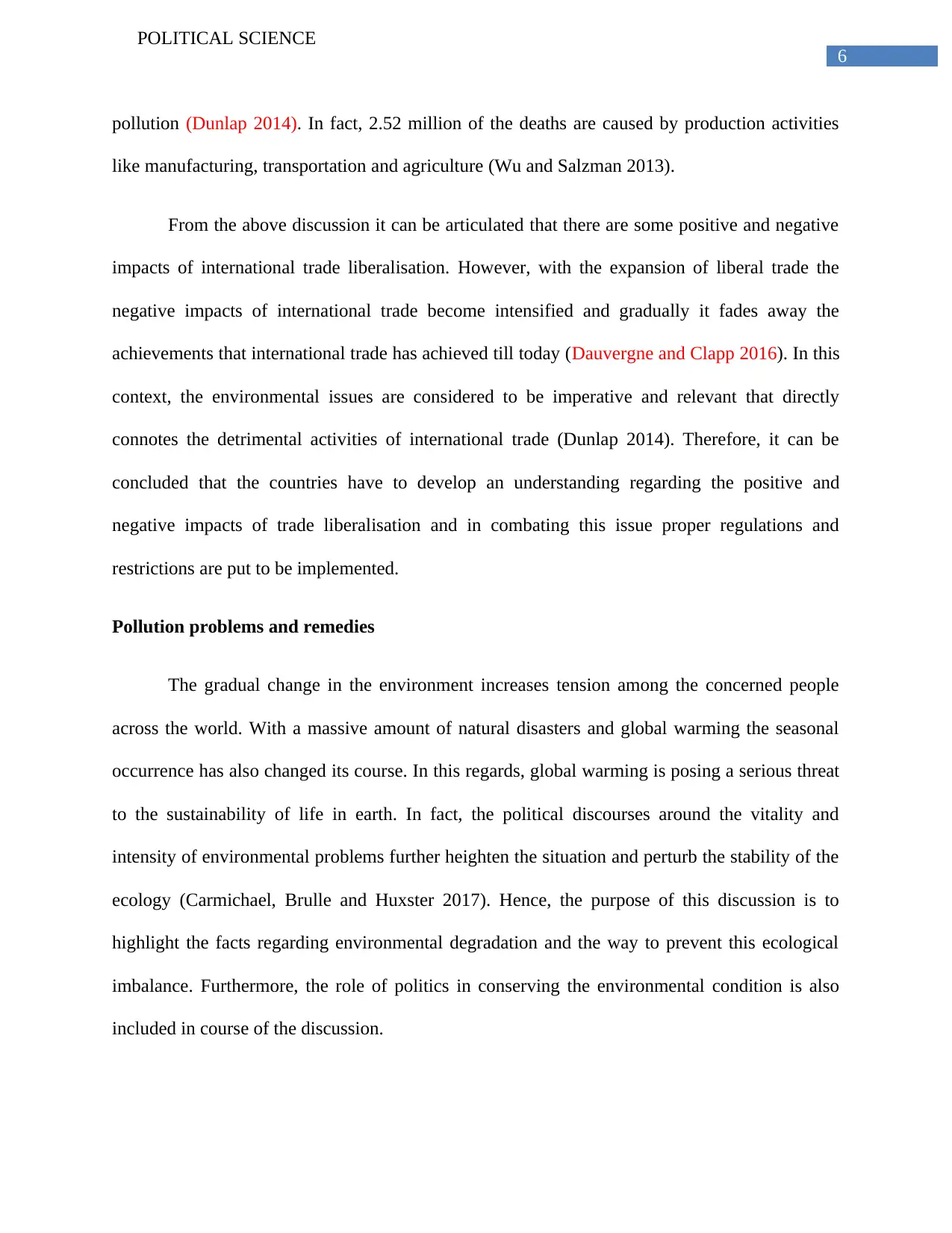
6
POLITICAL SCIENCE
pollution (Dunlap 2014). In fact, 2.52 million of the deaths are caused by production activities
like manufacturing, transportation and agriculture (Wu and Salzman 2013).
From the above discussion it can be articulated that there are some positive and negative
impacts of international trade liberalisation. However, with the expansion of liberal trade the
negative impacts of international trade become intensified and gradually it fades away the
achievements that international trade has achieved till today (Dauvergne and Clapp 2016). In this
context, the environmental issues are considered to be imperative and relevant that directly
connotes the detrimental activities of international trade (Dunlap 2014). Therefore, it can be
concluded that the countries have to develop an understanding regarding the positive and
negative impacts of trade liberalisation and in combating this issue proper regulations and
restrictions are put to be implemented.
Pollution problems and remedies
The gradual change in the environment increases tension among the concerned people
across the world. With a massive amount of natural disasters and global warming the seasonal
occurrence has also changed its course. In this regards, global warming is posing a serious threat
to the sustainability of life in earth. In fact, the political discourses around the vitality and
intensity of environmental problems further heighten the situation and perturb the stability of the
ecology (Carmichael, Brulle and Huxster 2017). Hence, the purpose of this discussion is to
highlight the facts regarding environmental degradation and the way to prevent this ecological
imbalance. Furthermore, the role of politics in conserving the environmental condition is also
included in course of the discussion.
POLITICAL SCIENCE
pollution (Dunlap 2014). In fact, 2.52 million of the deaths are caused by production activities
like manufacturing, transportation and agriculture (Wu and Salzman 2013).
From the above discussion it can be articulated that there are some positive and negative
impacts of international trade liberalisation. However, with the expansion of liberal trade the
negative impacts of international trade become intensified and gradually it fades away the
achievements that international trade has achieved till today (Dauvergne and Clapp 2016). In this
context, the environmental issues are considered to be imperative and relevant that directly
connotes the detrimental activities of international trade (Dunlap 2014). Therefore, it can be
concluded that the countries have to develop an understanding regarding the positive and
negative impacts of trade liberalisation and in combating this issue proper regulations and
restrictions are put to be implemented.
Pollution problems and remedies
The gradual change in the environment increases tension among the concerned people
across the world. With a massive amount of natural disasters and global warming the seasonal
occurrence has also changed its course. In this regards, global warming is posing a serious threat
to the sustainability of life in earth. In fact, the political discourses around the vitality and
intensity of environmental problems further heighten the situation and perturb the stability of the
ecology (Carmichael, Brulle and Huxster 2017). Hence, the purpose of this discussion is to
highlight the facts regarding environmental degradation and the way to prevent this ecological
imbalance. Furthermore, the role of politics in conserving the environmental condition is also
included in course of the discussion.
Paraphrase This Document
Need a fresh take? Get an instant paraphrase of this document with our AI Paraphraser
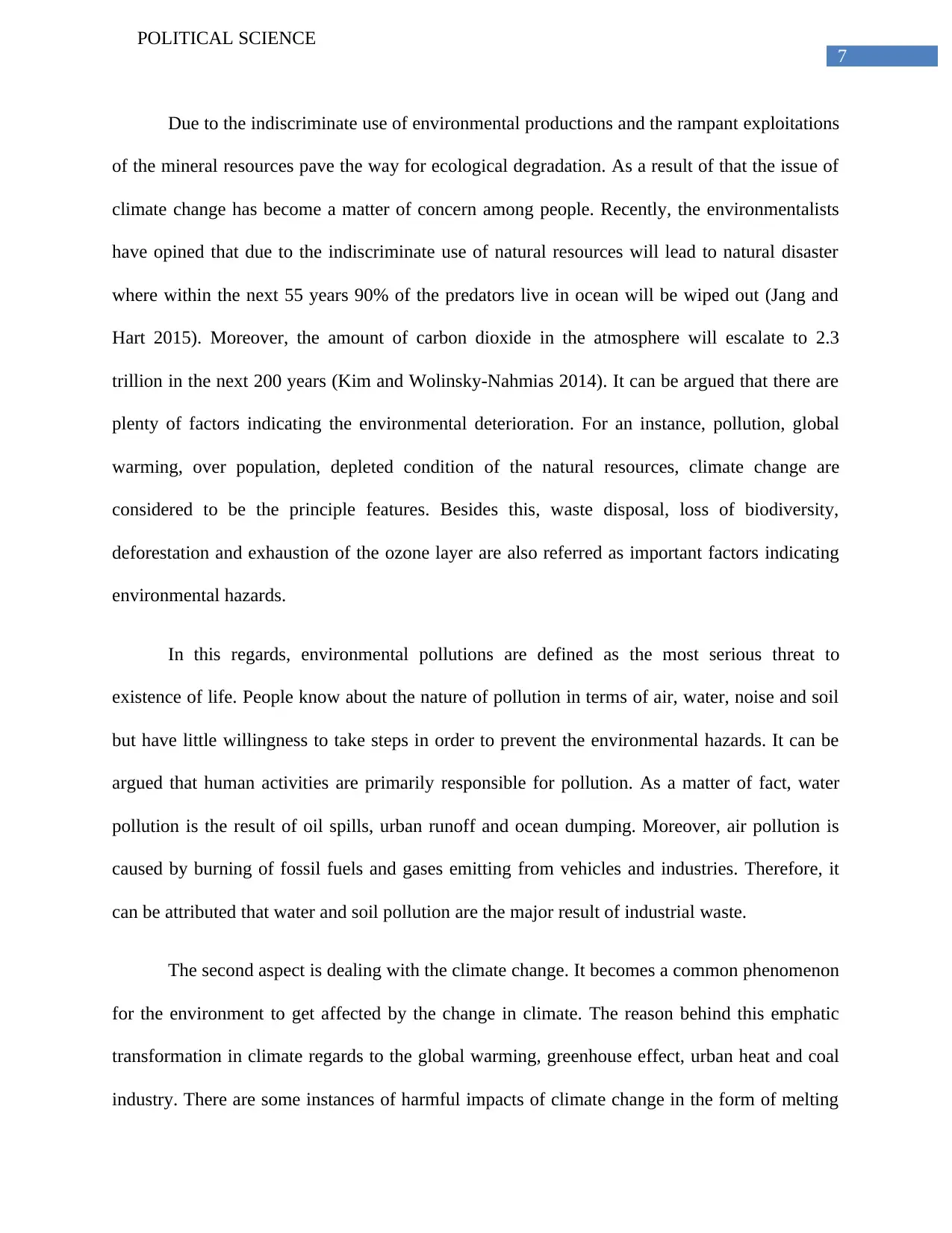
7
POLITICAL SCIENCE
Due to the indiscriminate use of environmental productions and the rampant exploitations
of the mineral resources pave the way for ecological degradation. As a result of that the issue of
climate change has become a matter of concern among people. Recently, the environmentalists
have opined that due to the indiscriminate use of natural resources will lead to natural disaster
where within the next 55 years 90% of the predators live in ocean will be wiped out (Jang and
Hart 2015). Moreover, the amount of carbon dioxide in the atmosphere will escalate to 2.3
trillion in the next 200 years (Kim and Wolinsky-Nahmias 2014). It can be argued that there are
plenty of factors indicating the environmental deterioration. For an instance, pollution, global
warming, over population, depleted condition of the natural resources, climate change are
considered to be the principle features. Besides this, waste disposal, loss of biodiversity,
deforestation and exhaustion of the ozone layer are also referred as important factors indicating
environmental hazards.
In this regards, environmental pollutions are defined as the most serious threat to
existence of life. People know about the nature of pollution in terms of air, water, noise and soil
but have little willingness to take steps in order to prevent the environmental hazards. It can be
argued that human activities are primarily responsible for pollution. As a matter of fact, water
pollution is the result of oil spills, urban runoff and ocean dumping. Moreover, air pollution is
caused by burning of fossil fuels and gases emitting from vehicles and industries. Therefore, it
can be attributed that water and soil pollution are the major result of industrial waste.
The second aspect is dealing with the climate change. It becomes a common phenomenon
for the environment to get affected by the change in climate. The reason behind this emphatic
transformation in climate regards to the global warming, greenhouse effect, urban heat and coal
industry. There are some instances of harmful impacts of climate change in the form of melting
POLITICAL SCIENCE
Due to the indiscriminate use of environmental productions and the rampant exploitations
of the mineral resources pave the way for ecological degradation. As a result of that the issue of
climate change has become a matter of concern among people. Recently, the environmentalists
have opined that due to the indiscriminate use of natural resources will lead to natural disaster
where within the next 55 years 90% of the predators live in ocean will be wiped out (Jang and
Hart 2015). Moreover, the amount of carbon dioxide in the atmosphere will escalate to 2.3
trillion in the next 200 years (Kim and Wolinsky-Nahmias 2014). It can be argued that there are
plenty of factors indicating the environmental deterioration. For an instance, pollution, global
warming, over population, depleted condition of the natural resources, climate change are
considered to be the principle features. Besides this, waste disposal, loss of biodiversity,
deforestation and exhaustion of the ozone layer are also referred as important factors indicating
environmental hazards.
In this regards, environmental pollutions are defined as the most serious threat to
existence of life. People know about the nature of pollution in terms of air, water, noise and soil
but have little willingness to take steps in order to prevent the environmental hazards. It can be
argued that human activities are primarily responsible for pollution. As a matter of fact, water
pollution is the result of oil spills, urban runoff and ocean dumping. Moreover, air pollution is
caused by burning of fossil fuels and gases emitting from vehicles and industries. Therefore, it
can be attributed that water and soil pollution are the major result of industrial waste.
The second aspect is dealing with the climate change. It becomes a common phenomenon
for the environment to get affected by the change in climate. The reason behind this emphatic
transformation in climate regards to the global warming, greenhouse effect, urban heat and coal
industry. There are some instances of harmful impacts of climate change in the form of melting
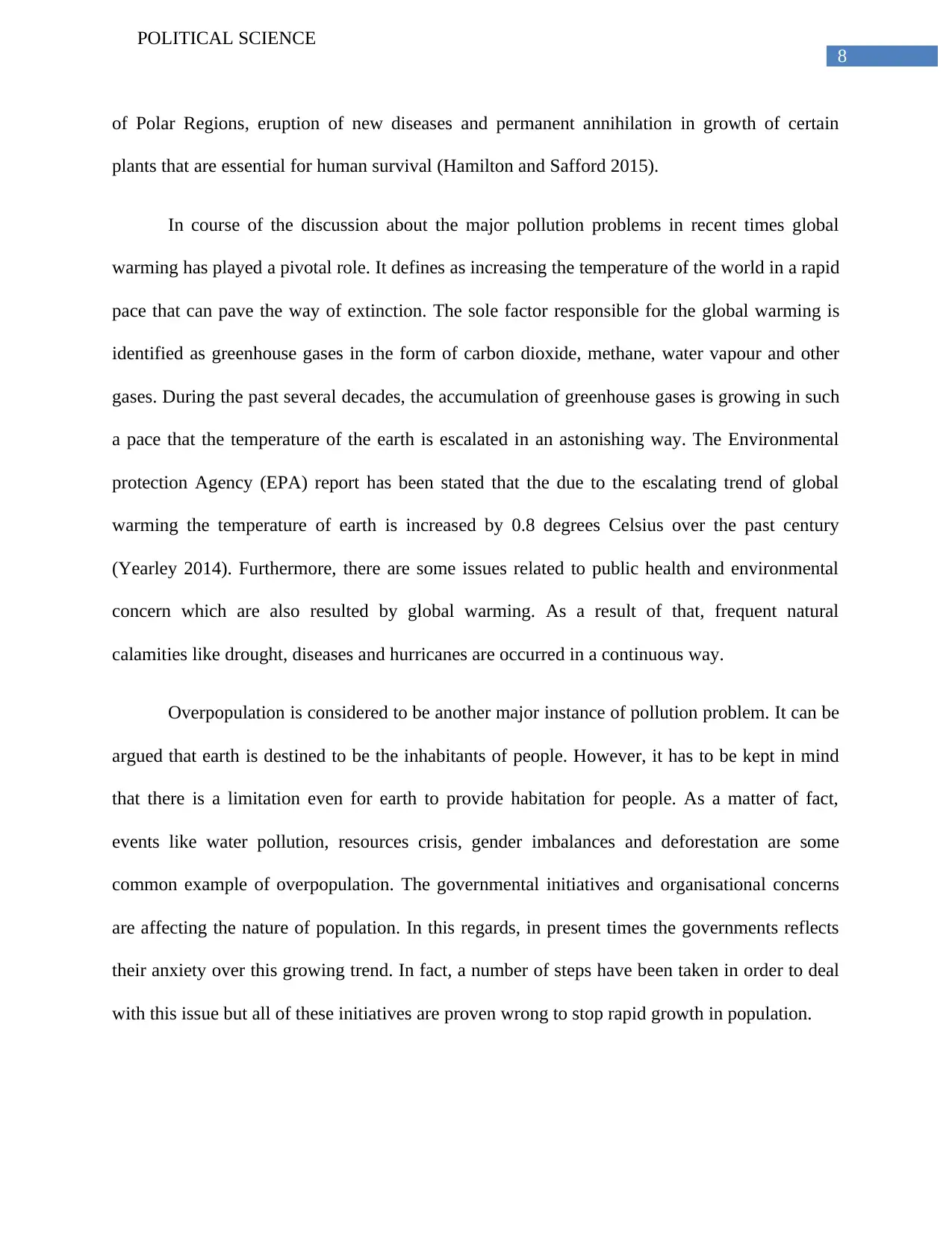
8
POLITICAL SCIENCE
of Polar Regions, eruption of new diseases and permanent annihilation in growth of certain
plants that are essential for human survival (Hamilton and Safford 2015).
In course of the discussion about the major pollution problems in recent times global
warming has played a pivotal role. It defines as increasing the temperature of the world in a rapid
pace that can pave the way of extinction. The sole factor responsible for the global warming is
identified as greenhouse gases in the form of carbon dioxide, methane, water vapour and other
gases. During the past several decades, the accumulation of greenhouse gases is growing in such
a pace that the temperature of the earth is escalated in an astonishing way. The Environmental
protection Agency (EPA) report has been stated that the due to the escalating trend of global
warming the temperature of earth is increased by 0.8 degrees Celsius over the past century
(Yearley 2014). Furthermore, there are some issues related to public health and environmental
concern which are also resulted by global warming. As a result of that, frequent natural
calamities like drought, diseases and hurricanes are occurred in a continuous way.
Overpopulation is considered to be another major instance of pollution problem. It can be
argued that earth is destined to be the inhabitants of people. However, it has to be kept in mind
that there is a limitation even for earth to provide habitation for people. As a matter of fact,
events like water pollution, resources crisis, gender imbalances and deforestation are some
common example of overpopulation. The governmental initiatives and organisational concerns
are affecting the nature of population. In this regards, in present times the governments reflects
their anxiety over this growing trend. In fact, a number of steps have been taken in order to deal
with this issue but all of these initiatives are proven wrong to stop rapid growth in population.
POLITICAL SCIENCE
of Polar Regions, eruption of new diseases and permanent annihilation in growth of certain
plants that are essential for human survival (Hamilton and Safford 2015).
In course of the discussion about the major pollution problems in recent times global
warming has played a pivotal role. It defines as increasing the temperature of the world in a rapid
pace that can pave the way of extinction. The sole factor responsible for the global warming is
identified as greenhouse gases in the form of carbon dioxide, methane, water vapour and other
gases. During the past several decades, the accumulation of greenhouse gases is growing in such
a pace that the temperature of the earth is escalated in an astonishing way. The Environmental
protection Agency (EPA) report has been stated that the due to the escalating trend of global
warming the temperature of earth is increased by 0.8 degrees Celsius over the past century
(Yearley 2014). Furthermore, there are some issues related to public health and environmental
concern which are also resulted by global warming. As a result of that, frequent natural
calamities like drought, diseases and hurricanes are occurred in a continuous way.
Overpopulation is considered to be another major instance of pollution problem. It can be
argued that earth is destined to be the inhabitants of people. However, it has to be kept in mind
that there is a limitation even for earth to provide habitation for people. As a matter of fact,
events like water pollution, resources crisis, gender imbalances and deforestation are some
common example of overpopulation. The governmental initiatives and organisational concerns
are affecting the nature of population. In this regards, in present times the governments reflects
their anxiety over this growing trend. In fact, a number of steps have been taken in order to deal
with this issue but all of these initiatives are proven wrong to stop rapid growth in population.
⊘ This is a preview!⊘
Do you want full access?
Subscribe today to unlock all pages.

Trusted by 1+ million students worldwide
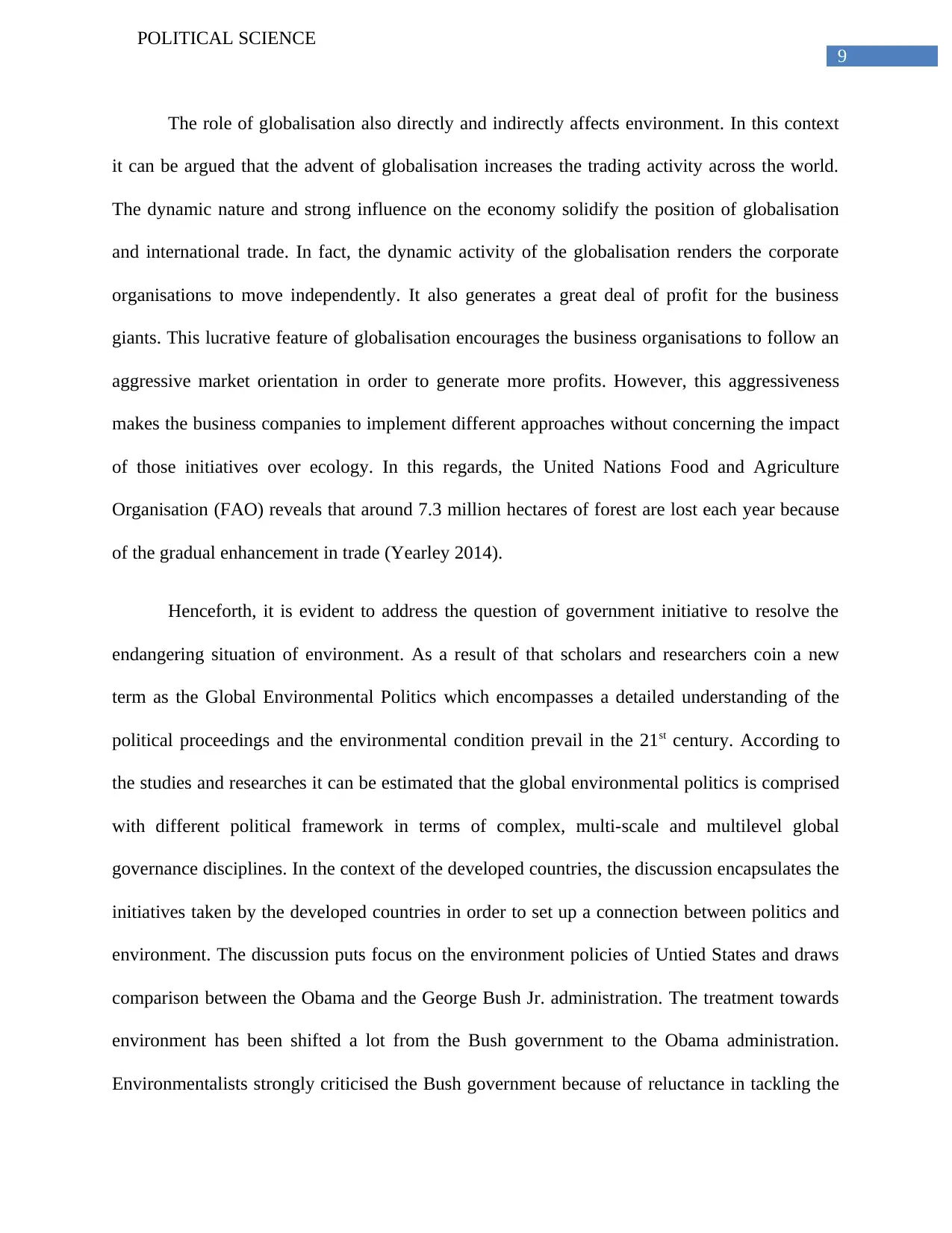
9
POLITICAL SCIENCE
The role of globalisation also directly and indirectly affects environment. In this context
it can be argued that the advent of globalisation increases the trading activity across the world.
The dynamic nature and strong influence on the economy solidify the position of globalisation
and international trade. In fact, the dynamic activity of the globalisation renders the corporate
organisations to move independently. It also generates a great deal of profit for the business
giants. This lucrative feature of globalisation encourages the business organisations to follow an
aggressive market orientation in order to generate more profits. However, this aggressiveness
makes the business companies to implement different approaches without concerning the impact
of those initiatives over ecology. In this regards, the United Nations Food and Agriculture
Organisation (FAO) reveals that around 7.3 million hectares of forest are lost each year because
of the gradual enhancement in trade (Yearley 2014).
Henceforth, it is evident to address the question of government initiative to resolve the
endangering situation of environment. As a result of that scholars and researchers coin a new
term as the Global Environmental Politics which encompasses a detailed understanding of the
political proceedings and the environmental condition prevail in the 21st century. According to
the studies and researches it can be estimated that the global environmental politics is comprised
with different political framework in terms of complex, multi-scale and multilevel global
governance disciplines. In the context of the developed countries, the discussion encapsulates the
initiatives taken by the developed countries in order to set up a connection between politics and
environment. The discussion puts focus on the environment policies of Untied States and draws
comparison between the Obama and the George Bush Jr. administration. The treatment towards
environment has been shifted a lot from the Bush government to the Obama administration.
Environmentalists strongly criticised the Bush government because of reluctance in tackling the
POLITICAL SCIENCE
The role of globalisation also directly and indirectly affects environment. In this context
it can be argued that the advent of globalisation increases the trading activity across the world.
The dynamic nature and strong influence on the economy solidify the position of globalisation
and international trade. In fact, the dynamic activity of the globalisation renders the corporate
organisations to move independently. It also generates a great deal of profit for the business
giants. This lucrative feature of globalisation encourages the business organisations to follow an
aggressive market orientation in order to generate more profits. However, this aggressiveness
makes the business companies to implement different approaches without concerning the impact
of those initiatives over ecology. In this regards, the United Nations Food and Agriculture
Organisation (FAO) reveals that around 7.3 million hectares of forest are lost each year because
of the gradual enhancement in trade (Yearley 2014).
Henceforth, it is evident to address the question of government initiative to resolve the
endangering situation of environment. As a result of that scholars and researchers coin a new
term as the Global Environmental Politics which encompasses a detailed understanding of the
political proceedings and the environmental condition prevail in the 21st century. According to
the studies and researches it can be estimated that the global environmental politics is comprised
with different political framework in terms of complex, multi-scale and multilevel global
governance disciplines. In the context of the developed countries, the discussion encapsulates the
initiatives taken by the developed countries in order to set up a connection between politics and
environment. The discussion puts focus on the environment policies of Untied States and draws
comparison between the Obama and the George Bush Jr. administration. The treatment towards
environment has been shifted a lot from the Bush government to the Obama administration.
Environmentalists strongly criticised the Bush government because of reluctance in tackling the
Paraphrase This Document
Need a fresh take? Get an instant paraphrase of this document with our AI Paraphraser
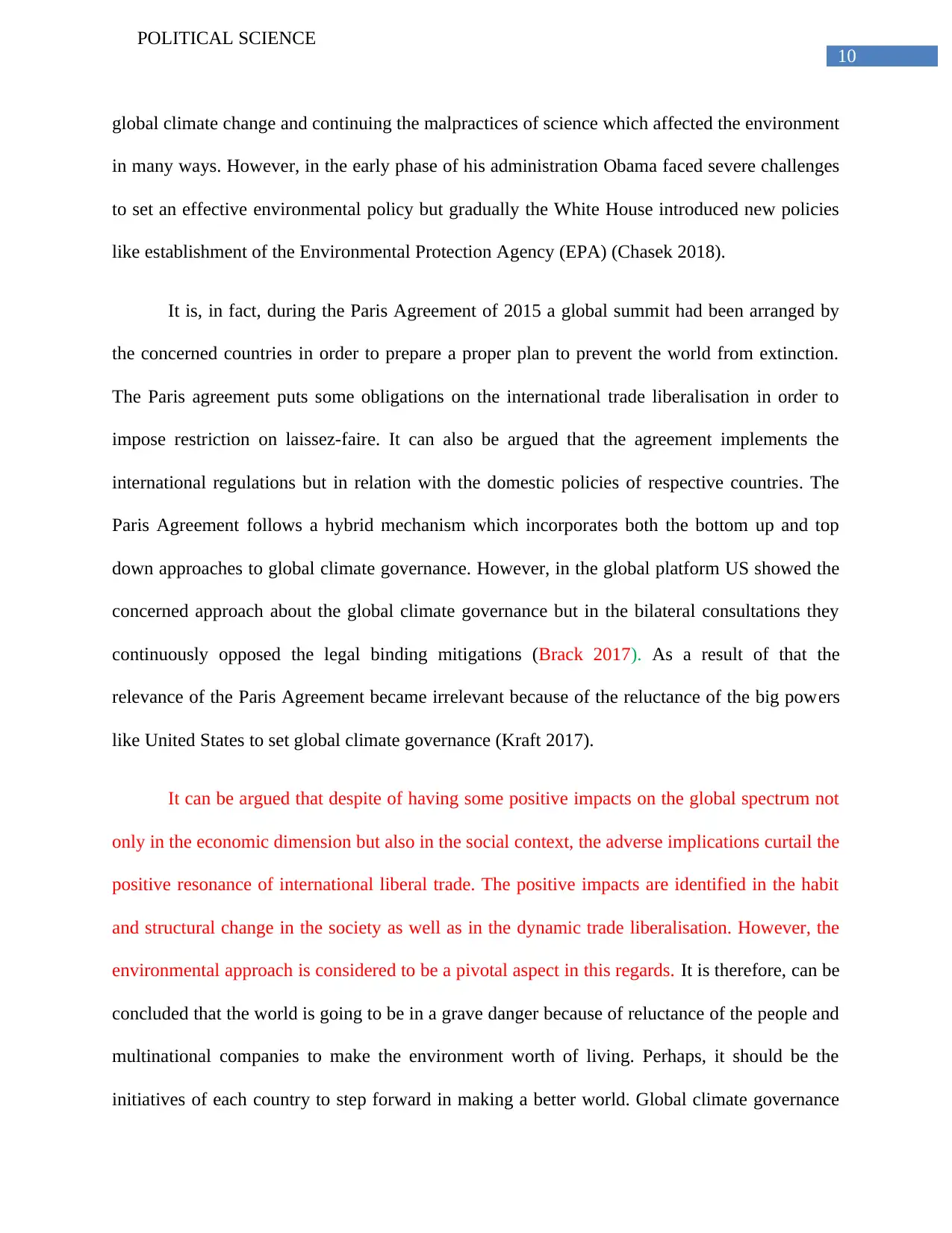
10
POLITICAL SCIENCE
global climate change and continuing the malpractices of science which affected the environment
in many ways. However, in the early phase of his administration Obama faced severe challenges
to set an effective environmental policy but gradually the White House introduced new policies
like establishment of the Environmental Protection Agency (EPA) (Chasek 2018).
It is, in fact, during the Paris Agreement of 2015 a global summit had been arranged by
the concerned countries in order to prepare a proper plan to prevent the world from extinction.
The Paris agreement puts some obligations on the international trade liberalisation in order to
impose restriction on laissez-faire. It can also be argued that the agreement implements the
international regulations but in relation with the domestic policies of respective countries. The
Paris Agreement follows a hybrid mechanism which incorporates both the bottom up and top
down approaches to global climate governance. However, in the global platform US showed the
concerned approach about the global climate governance but in the bilateral consultations they
continuously opposed the legal binding mitigations (Brack 2017). As a result of that the
relevance of the Paris Agreement became irrelevant because of the reluctance of the big powers
like United States to set global climate governance (Kraft 2017).
It can be argued that despite of having some positive impacts on the global spectrum not
only in the economic dimension but also in the social context, the adverse implications curtail the
positive resonance of international liberal trade. The positive impacts are identified in the habit
and structural change in the society as well as in the dynamic trade liberalisation. However, the
environmental approach is considered to be a pivotal aspect in this regards. It is therefore, can be
concluded that the world is going to be in a grave danger because of reluctance of the people and
multinational companies to make the environment worth of living. Perhaps, it should be the
initiatives of each country to step forward in making a better world. Global climate governance
POLITICAL SCIENCE
global climate change and continuing the malpractices of science which affected the environment
in many ways. However, in the early phase of his administration Obama faced severe challenges
to set an effective environmental policy but gradually the White House introduced new policies
like establishment of the Environmental Protection Agency (EPA) (Chasek 2018).
It is, in fact, during the Paris Agreement of 2015 a global summit had been arranged by
the concerned countries in order to prepare a proper plan to prevent the world from extinction.
The Paris agreement puts some obligations on the international trade liberalisation in order to
impose restriction on laissez-faire. It can also be argued that the agreement implements the
international regulations but in relation with the domestic policies of respective countries. The
Paris Agreement follows a hybrid mechanism which incorporates both the bottom up and top
down approaches to global climate governance. However, in the global platform US showed the
concerned approach about the global climate governance but in the bilateral consultations they
continuously opposed the legal binding mitigations (Brack 2017). As a result of that the
relevance of the Paris Agreement became irrelevant because of the reluctance of the big powers
like United States to set global climate governance (Kraft 2017).
It can be argued that despite of having some positive impacts on the global spectrum not
only in the economic dimension but also in the social context, the adverse implications curtail the
positive resonance of international liberal trade. The positive impacts are identified in the habit
and structural change in the society as well as in the dynamic trade liberalisation. However, the
environmental approach is considered to be a pivotal aspect in this regards. It is therefore, can be
concluded that the world is going to be in a grave danger because of reluctance of the people and
multinational companies to make the environment worth of living. Perhaps, it should be the
initiatives of each country to step forward in making a better world. Global climate governance

11
POLITICAL SCIENCE
and the role of the international agreements like Paris Agreement are significant and necessitated
for a sustainable world.
POLITICAL SCIENCE
and the role of the international agreements like Paris Agreement are significant and necessitated
for a sustainable world.
⊘ This is a preview!⊘
Do you want full access?
Subscribe today to unlock all pages.

Trusted by 1+ million students worldwide
1 out of 15
Related Documents
Your All-in-One AI-Powered Toolkit for Academic Success.
+13062052269
info@desklib.com
Available 24*7 on WhatsApp / Email
![[object Object]](/_next/static/media/star-bottom.7253800d.svg)
Unlock your academic potential
Copyright © 2020–2025 A2Z Services. All Rights Reserved. Developed and managed by ZUCOL.




